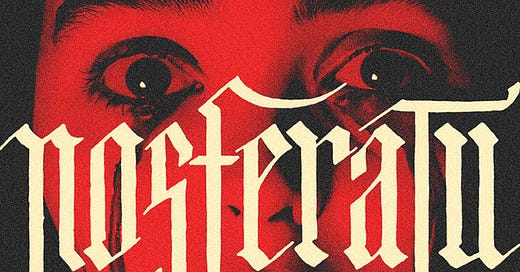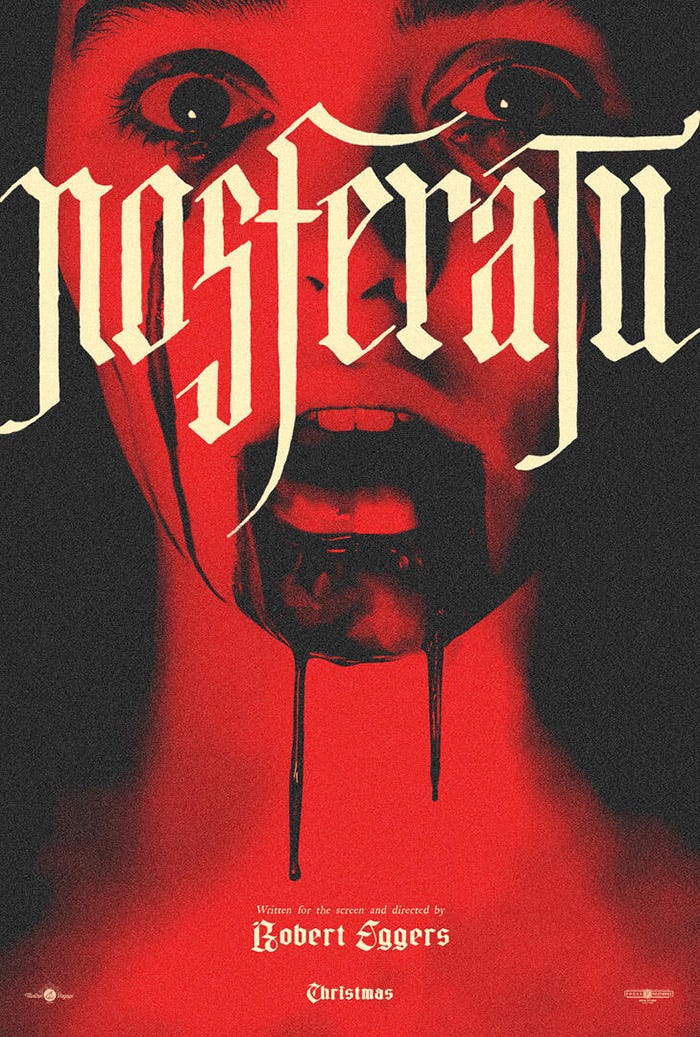Hi all, and welcome back to rumblewrites. This week’s post is another film review, this time of the 2024 remake of Nosferatu. If you enjoy this article, you can find my other reviews here, and subscribe for more:
Immediate disclosure: I have not seen Murnau’s 1922 Nosferatu film. This review will not be a comparison between the two, nor will it really engage with the source material of Bram Stoker’s Dracula (although I have read that, and I would highly recommend it - it’s a great book).
Warning: *spoilers ahead*
Synopsis
Nosferatu is set in Wisburg, Germany in the early 1800s. It follows a young woman named Ellen (Lily-Rose Depp) and her unfortunate encounter with the creature known as Nosferatu (Bill Skarsgård).
The film starts in Ellen’s youth, with her calling into the night:
I sought company. I sought…tenderness and, I called out. At first it was sweet. I had never known such bliss. And it turned to torture, it would kill me.
Her cries are answered by a supernatural being who descends upon her as a shadow. The scene is lustful, and Ellen promises herself to him for eternity. But then, he materialises. A thin, gnarled hand grips her throat, and she screams in terror.
Fast-forward a few years and Ellen is now happily (or thereabouts) married to an estate agent named Thomas Hutter (Nicholas Hoult). Thomas is set on improving their fortunes by becoming a partner in his firm - but to prove his worth, he must first journey to Transylvania to secure a contract with one Count Orlock. Ellen warns him against this, citing her recent nightmares as omens of his misfortune in Romania. But Thomas does not heed her advice, instead deciding to leave immediately, and to lodge Ellen with his friend Friedrich Harding (Aaron Taylor-Johnson), his wife Anna (Emma Corrin), and their two daughters.
Thomas travels to Romania and decides to rest a night in a nearby village. But his sleep is interrupted by their ceremonious killing of what seems to be a vampire. Thomas wakes up the following morning in a cold sweat, still wearing his muddied boots, and emerges from the tavern to find the village deserted. He continues to the castle on foot and is shortly met by a driverless carriage which escorts him to the Count.
Within moments of their meeting, Thomas is forced to sign the property contract. Unwittingly, he also signs paperwork which voids his marriage to Ellen. He is then taken ill, and wakes the following morning with bite marks on his chest. He discovers the Count lying in a coffin and attempts to kill him by driving a wooden stake through his heart, in the same manner as he had seen the village people kill their vampire. But the Count wakes and attacks Thomas first, feeding on his blood once more. Thomas is weakened but manages to escape, stumbling into a nearby church where he is nursed back to health by Orthodox nuns.
Meanwhile, in Germany, Ellen has been suffering from intense (and wanton) seizures. Friedrich sends for a doctor, but he is unable to help, and so he calls on his old mentor: Albin Eberhard Von Franz (Willem Dafoe), a scientist ostracised for his occultist beliefs. Albin believes Ellen to be under the spell of Nosferatu, a demonic, plague-bearing vampire.
It is at this point that Thomas, still severely unwell, makes his return. He is desperate to warn Ellen of the Count’s obsession with her, but she is, of course, already aware. The Count follows close behind, bringing plague rats to Germany. The city is plunged into a frenzy and Orlock threatens to kill Ellen’s friends and family if she does not willingly submit herself to him. Over the next two nights, he murders Anna and her daughters. Friedrich, driven mad with grief, dies while holding her corpse.
The film ends with Ellen accepting Nosferatu in a gruesome act of self-sacrifice. She keeps him in her bed until morning, when the sun’s rays kill him. Drained of blood, Ellen dies beneath his rotting body.
Analysis
Nosferatu is the fourth film by director Robert Eggers, following his The Witch (2015), The Lighthouse (2019), and The Northman (2022). Likewise critically acclaimed, Nosferatu does not disappoint. It is just as dark, just as horrific, and just as triumphant. It has recently been nominated for four Oscars: Make-up and Hair, Costume Design, Cinematography, and Production Design. It should therefore come as no surprise when I say that it is aesthetically masterful. Eggers has a unique eye for detail, with costumes, props, and set all holding true to their nineteenth century setting. The architecture is suitably imposing, Romantic and religious symbols are scattered throughout, and the whole film adopts a near-monochromatic look. In short, it’s truly Gothic.
At its heart, however, is the performance of Skarsgård, who is buried under a mountain of prosthetics but gives a characteristically terrifying interpretation of the titular Nosferatu. Supporting him, Depp and Hoult are less preposterous, their tender yet often emotionally violent conduct adding a sense of gravitas to the film. Taylor-Johnson, Corrin, and Dafoe give slightly less memorable, albeit good, performances. Despite this, the plot itself is somewhat lacking. The story is slow in places, and we get much more of Orlock’s coming than his actual arrival: the terror he spreads in Wisburg is undercut by its brevity. There are some slight moments of humour, however, and I was never bored. As a whole, Nosferatu certainly values style over substance, but that isn’t necessarily a bad thing.
Does evil come from within us or from beyond?
A woman’s sexuality is a devilish thing. This is the crux of the film: how are we to interpret Ellen’s “unusual” sexual appetite?
At a time when patriarchal oppression is still flourishing, women need not tell men that we like being dominated. But neither should we be ashamed of our preferences in the bedroom. Women are tired of being told what we should and shouldn’t like, how we ought to behave, and what sex should look and feel like. Films like Nosferatu and Babygirl hold a mirror up to society’s view of women in sexual relationships, exposing our historic and continued repression of female sexual desire. They show us that, to some extent, emancipation comes from allowing ourselves to do exactly what we are told not to: submit. At least, in the cases of Ellen and Romy. These are hardly didactic films.
So too do they show sexuality and attraction as complex, and oftentimes dirty, things. The relationships depicted by both Babygirl and Nosferatu are transgressive, and this is exactly what transfixes us. Elle explains this phenomenon well in her article, so I’ll leave the explanation down to her:
But the fact of the matter is, Nosferatu makes us feel uncomfortable. At Nosferatu’s physicality, at Ellen’s possession, at their entwined desire, and at our own views of women’s sexuality. This is a tale of possession, destructive eroticism, longing, and shame. Like Ellen, we are disgusted as much as we are seduced.
But Eggers’ presentation of female sexuality is not a binary matter. Ellen and her lust are central to the narrative: it was she who awoke Nosferatu, and she too who must end his life. But her choice to do so is not a feminist act. She does not achieve sexual autonomy, and she continues to be demonised by all around her besides Thomas. Neither, however, is she presented as a victim: it is Thomas who occupies the more traditional damsel-in-distress role, while Ellen takes what little power she has to end Nosferatu’s reign of terror.
She uses her sexuality to entrap him, but this does not make her a temptress. She gains nothing (besides temporary sexual satisfaction), and she loses her life. It reminds me of the complex depiction of desire and loss in Keats’ La Belle Dame Sans Merci, where the belle dame is at once the victim and seductress of the knight:
She took me to her Elfin grot,
And there she wept and sighed full sore,
And there I shut her wild wild eyes
With kisses four.
Some have said Eggers’ depiction of female sexuality is stunted, but I disagree. Mainly because I don’t think it was the point of the film. Yes, I would’ve liked it more firmly grounded in contemporary medicine - think hysteria, nerves, asylums, as I have previously written about - but at the end of the day, Nosferatu is not trying to provide an overt commentary on female sexuality. It does not portray Ellen’s decision as a consensual act (because it most certainly wasn’t one), and I actually think it deals with the complex relationship between female desire and oppression very well. As I said earlier, it isn’t supposed to be didactic - it gives you enough to think about while focusing its main efforts on.. well, being a horror film.
“I don’t like scary films, can I watch this?”
Maybe? There are a couple of minor jump scares, visuals of blood and a nondescript black goo (pictured above), physical violence (including rape and murder), and a general sense of melancholy and unease throughout. It’s unnerving, ominous, and brooding, but not all out scary. Think Gothic more than new-world horror. It depends on your vices, really.







Great essay! I love The Witch and appreciate The Lighthouse, though Nosferatu was definitely more about the visual style for me. While it's a story we all know quite well by now, Eggers and co. managed to bring something new to the table in terms of design and performance. Your reading into the sexual context really opened my eyes to the social commentary aspect that I admittedly overlooked in my own review.
Thank you, Lucy. I've been wondering whether I should go and see this. I have seen the 1922 film long time ago, and loved it. Your review makes me want to go.